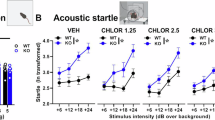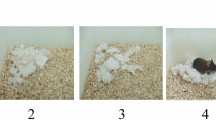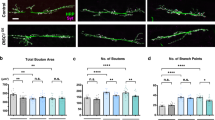Abstract
Fragile X syndrome is caused by the functional loss of the fragile X mental retardation 1 (FMR1) gene. Deletion of the FMR1 ortholog in Drosophila melanogaster (Fmr1) recapitulates many phenotypes associated with fragile X syndrome. We have discovered that Fmr1 mutant Drosophila die during development when reared on food containing increased levels of glutamate, which is consistent with the theory that FMR1 loss results in excess glutamate signaling. Using this lethal phenotype, we screened a chemical library of 2,000 compounds and identified nine molecules that rescued the lethality, including three that implicate the GABAergic inhibitory pathway. Indeed, GABA treatment rescued several known Fmr1 mutant phenotypes in flies, including mushroom bodies defects, excess Futsch translation and abnormal male courtship behavior. These data are consistent with GABAergic inhibition of the enhanced excitatory pathway in fragile X syndrome. In addition, our screen reveals that the muscarinic cholinergic receptors may have a role in fragile X syndrome in parallel to the GABAergic pathway. These results point to potential therapeutic approaches for treating fragile X syndrome.
This is a preview of subscription content, access via your institution
Access options
Subscribe to this journal
Receive 12 print issues and online access
$259.00 per year
only $21.58 per issue
Buy this article
- Purchase on SpringerLink
- Instant access to full article PDF
Prices may be subject to local taxes which are calculated during checkout





Similar content being viewed by others
References
Penagarikano, O., Mulle, J.G. & Warren, S.T. The pathophysiology of fragile x syndrome. Annu. Rev. Genomics Hum. Genet. 8, 109–129 (2007).
Feng, Y. et al. FMRP associates with polyribosomes as an mRNP, and the I304N mutation of severe fragile X syndrome abolishes this association. Mol. Cell 1, 109–118 (1997).
Todd, P.K., Mack, K.J. & Malter, J.S. The fragile X mental retardation protein is required for type-I metabotropic glutamate receptor-dependent translation of PSD-95. Proc. Natl. Acad. Sci. USA 100, 14374–14378 (2003).
Brown, V. et al. Microarray identification of FMRP-associated brain mRNAs and altered mRNA translational profiles in fragile X syndrome. Cell 107, 477–487 (2001).
Darnell, J.C. et al. Fragile X mental retardation protein targets G quartet mRNAs important for neuronal function. Cell 107, 489–499 (2001).
Zhang, Y.Q. et al. The Drosophila fragile X-related gene regulates axoneme differentiation during spermatogenesis. Dev. Biol. 270, 290–307 (2004).
Lu, R. et al. The fragile X protein controls microtubule-associated protein 1B translation and microtubule stability in brain neuron development. Proc. Natl. Acad. Sci. USA 101, 15201–15206 (2004).
Jin, P., Alisch, R.S. & Warren, S.T. RNA and microRNAs in fragile X mental retardation. Nat. Cell Biol. 6, 1048–1053 (2004).
Bear, M.F., Huber, K.M. & Warren, S.T. The mGluR theory of fragile X mental retardation. Trends Neurosci. 27, 370–377 (2004).
Vanderklish, P.W. & Edelman, G.M. Differential translation and fragile X syndrome. Genes Brain Behav. 4, 360–384 (2005).
Yan, Q.J., Rammal, M., Tranfaglia, M. & Bauchwitz, R.P. Suppression of two major Fragile X Syndrome mouse model phenotypes by the mGluR5 antagonist MPEP. Neuropharmacology 49, 1053–1066 (2005).
McBride, S.M. et al. Pharmacological rescue of synaptic plasticity, courtship behavior, and mushroom body defects in a Drosophila model of fragile x syndrome. Neuron 45, 753–764 (2005).
Gao, F.B. Understanding fragile X syndrome: insights from retarded flies. Neuron 34, 859–862 (2002).
Wan, L., Dockendorff, T.C., Jongens, T.A. & Dreyfuss, G. Characterization of dFMR1, a Drosophila melanogaster homolog of the fragile X mental retardation protein. Mol. Cell. Biol. 20, 8536–8547 (2000).
Lee, A. et al. Control of dendritic development by the Drosophila fragile X-related gene involves the small GTPase Rac1. Development 130, 5543–5552 (2003).
Zhang, Y.Q. et al. Drosophila fragile X-related gene regulates the MAP1B homolog Futsch to control synaptic structure and function. Cell 107, 591–603 (2001).
Reeve, S.P. et al. The Drosophila fragile X mental retardation protein controls actin dynamics by directly regulating profilin in the brain. Curr. Biol. 15, 1156–1163 (2005).
Morales, J. et al. Drosophila fragile X protein, DFXR, regulates neuronal morphology and function in the brain. Neuron 34, 961–972 (2002).
Dockendorff, T.C. et al. Drosophila lacking dfmr1 activity show defects in circadian output and fail to maintain courtship interest. Neuron 34, 973–984 (2002).
Michel, C.I., Kraft, R. & Restifo, L.L. Defective neuronal development in the mushroom bodies of Drosophila fragile X mental retardation 1 mutants. J. Neurosci. 24, 5798–5809 (2004).
Pan, L., Zhang, Y.Q., Woodruff, E. & Broadie, K. The Drosophila fragile x gene negatively regulates neuronal elaboration and synaptic differentiation. Curr. Biol. 14, 1863–1870 (2004).
Krogsgaard-Larsen, P., Frolund, B. & Frydenvang, K. GABA uptake inhibitors. Design, molecular pharmacology and therapeutic aspects. Curr. Pharm. Des. 6, 1193–1209 (2000).
Reith, M.E., Zhen, J. & Chen, N. The importance of company: Na+ and Cl– influence substrate interaction with SLC6 transporters and other proteins. Handb. Exp. Pharmacol. 75–93 (2006).
Weinberger, N.M. Food for thought: honeybee foraging, memory, and acetylcholine. Sci. STKE 2006, pe23 (2006).
Ismail, N., Robinson, G.E. & Fahrbach, S.E. Stimulation of muscarinic receptors mimics experience-dependent plasticity in the honey bee brain. Proc. Natl. Acad. Sci. USA 103, 207–211 (2006).
Root, C.M., Semmelhack, J.L., Wong, A.M., Flores, J. & Wang, J.W. Propagation of olfactory information in Drosophila. Proc. Natl. Acad. Sci. USA 104, 11826–11831 (2007).
Wilson, R.I. & Laurent, G. Role of GABAergic inhibition in shaping odor-evoked spatiotemporal patterns in the Drosophila antennal lobe. J. Neurosci. 25, 9069–9079 (2005).
Heisenberg, M. Mushroom body memoir: from maps to models. Nat. Rev. Neurosci. 4, 266–275 (2003).
Hall, J.C. The mating of a fly. Science 264, 1702–1714 (1994).
Siegel, R.W. & Hall, J.C. Conditioned responses in courtship behavior of normal and mutant Drosophila. Proc. Natl. Acad. Sci. USA 76, 3430–3434 (1979).
Bell, K.F. & Claudio Cuello, A. Altered synaptic function in Alzheimer's disease. Eur. J. Pharmacol. 545, 11–21 (2006).
Desai, U.A. et al. Biologically active molecules that reduce polyglutamine aggregation and toxicity. Hum. Mol. Genet. 15, 2114–2124 (2006).
Min, J. et al. Forward chemical genetic approach identifies new role for GAPDH in insulin signaling. Nat. Chem. Biol. 3, 55–59 (2007).
Moy, T.I. et al. Identification of novel antimicrobials using a live-animal infection model. Proc. Natl. Acad. Sci. USA 103, 10414–10419 (2006).
Segalat, L. Invertebrate animal models of diseases as screening tools in drug discovery. ACS Chem. Biol. 2, 231–236 (2007).
Hefco, V. et al. The interaction between the cholinergic and dopaminergic system in learning and memory process in rats. Rom. J. Physiol. 41, 21–30 (2004).
Pratt, W.E. & Kelley, A.E. Nucleus accumbens acetylcholine regulates appetitive learning and motivation for food via activation of muscarinic receptors. Behav. Neurosci. 118, 730–739 (2004).
Tzavara, E.T. et al. Dysregulated hippocampal acetylcholine neurotransmission and impaired cognition in M2, M4 and M2/M4 muscarinic receptor knockout mice. Mol. Psychiatry 8, 673–679 (2003).
Degroot, A., Salhoff, C., Davis, R.J. & Nomikos, G.G. Genetic deletion of CB1 receptors improves non-associative learning. Behav. Brain Res. 162, 161–164 (2005).
Lozano, V.C., Armengaud, C. & Gauthier, M. Memory impairment induced by cholinergic antagonists injected into the mushroom bodies of the honeybee. J. Comp. Physiol. [A] 187, 249–254 (2001).
D'Hulst, C. et al. Decreased expression of the GABAA receptor in fragile X syndrome. Brain Res. 1121, 238–245 (2006).
Gantois, I. et al. Expression profiling suggests underexpression of the GABA(A) receptor subunit delta in the fragile X knockout mouse model. Neurobiol. Dis. 21, 346–357 (2006).
El Idrissi, A. et al. Decreased GABA(A) receptor expression in the seizure-prone fragile X mouse. Neurosci. Lett. 377, 141–146 (2005).
Selby, L., Zhang, C. & Sun, Q.Q. Major defects in neocortical GABAergic inhibitory circuits in mice lacking the fragile X mental retardation protein. Neurosci. Lett. 412, 227–232 (2007).
Segal, M., Greenberger, V. & Korkotian, E. Formation of dendritic spines in cultured striatal neurons depends on excitatory afferent activity. Eur. J. Neurosci. 17, 2573–2585 (2003).
Brotz, T.M., Bochenek, B., Aronstein, K., Ffrench-Constant, R.H. & Borst, A. γ-Aminobutyric acid receptor distribution in the mushroom bodies of a fly (Calliphora erythrocephala): a functional subdivision of Kenyon cells? J. Comp. Neurol. 383, 42–48 (1997).
Strambi, C. et al. Immunocytochemical mapping of an RDL-like GABA receptor subunit and of GABA in brain structures related to learning and memory in the cricket Acheta domesticus. Learn. Mem. 5, 78–89 (1998).
Yamazaki, Y., Nishikawa, M. & Mizunami, M. Three classes of GABA-like immunoreactive neurons in the mushroom body of the cockroach. Brain Res. 788, 80–86 (1998).
Schurmann, F.W., Ottersen, O.P. & Honegger, H.W. Glutamate-like immunoreactivity marks compartments of the mushroom bodies in the brain of the cricket. J. Comp. Neurol. 418, 227–239 (2000).
Villella, A. & Hall, J.C. Courtship anomalies caused by doublesex mutations in Drosophila melanogaster. Genetics 143, 331–344 (1996).
Acknowledgements
We thank S. L'Hernault, T. Kroft, H. Liu and C. Yu for assistance. We thank Y. Feng and the members of the Warren and Jin labs for their assistance and critical comments. We thank T.A. Jongens (University of Pennsylvania) for providing the transgenic fly carrying a copy of the Fmr1 transgene. We also thank the National Institute of Child Health and Human Development (NICHD) Developmental Studies Hybridoma Bank at the University of Iowa for antibodies. S.C. is supported by a Fragile X Research Foundation (FRAXA) postdoctoral grant, and S.M.B. is supported by a Frederick Gardner Cottrell Fellowship at Emory University. This work was supported by US National Institutes of Health grants HD020521 and HD24064 to S.T.W. and by the Colonial Oaks Foundation.
Author information
Authors and Affiliations
Contributions
S.C. designed and performed experiments, analyzed data and wrote the manuscript; S.M.B. performed experiments, analyzed data and revised the manuscript; D.C.Z. and P.J. made initial observations; Z.L. and C.H. conducted the chemical analysis; P.J. designed the research and provided fly strains; S.T.W. designed and supervised the research, wrote and revised the manuscript and obtained funding for the research.
Corresponding author
Ethics declarations
Competing interests
S.T.W. declares he is chair of the Scientific Advisory Board of Seaside Therapeutics, Inc. The remaining authors declare that they have no competing financial interests.
Supplementary information
Supplementary Text and Figures
Supplementary Figures 1–7 and Supplementary Tables 1 and 2 (PDF 779 kb)
Rights and permissions
About this article
Cite this article
Chang, S., Bray, S., Li, Z. et al. Identification of small molecules rescuing fragile X syndrome phenotypes in Drosophila. Nat Chem Biol 4, 256–263 (2008). https://doi.org/10.1038/nchembio.78
Received:
Accepted:
Published:
Issue Date:
DOI: https://doi.org/10.1038/nchembio.78
This article is cited by
-
Drosophila olfaction as a model system for studying human neurological disorders
Journal of Biosciences (2023)
-
From bench to bedside: The mGluR5 system in people with and without Autism Spectrum Disorder and animal model systems
Translational Psychiatry (2022)
-
The remodel of the “central dogma”: a metabolomics interaction perspective
Metabolomics (2021)
-
Drosophila Netrin-B controls mushroom body axon extension and regulates courtship-associated learning and memory of a Drosophila fragile X syndrome model
Molecular Brain (2019)
-
Nutrigenomics as a tool to study the impact of diet on aging and age-related diseases: the Drosophila approach
Genes & Nutrition (2019)



